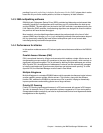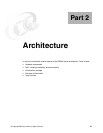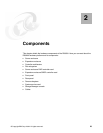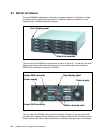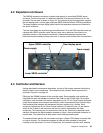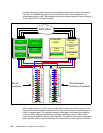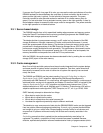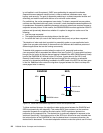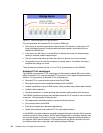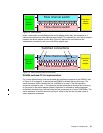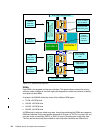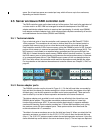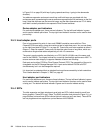Chapter 2. Components 27
If you can view Figure 2-4 on page 26 in color, you can use the colors as indicators of how the
DS6000 hardware is shared between the controllers (in black and white, the dark color is
green and the light color is yellow). On the left side is the green controller. The green
controller records its write data and caches its read data in its volatile memory area (in
green). For fast-write data it has a persistent memory area on the right controller. It uses its
device adapter chipset to access the disk arrays under its management. The yellow controller
on the right operates in an identical fashion.
2.3.1 Server-based design
The DS6800 benefits from a fully assembled, leading edge processor and memory system.
Using the PowerPC architecture as the primary processing engine sets the DS6800 apart
from other disk storage systems on the market.
The design decision to use processor memory as I/O cache is a key element of the IBM
storage architecture. Although a separate I/O cache could provide fast access, it cannot
match the access speed of main memory. The decision to use main memory as the cache
proved itself in three generations of the IBM Enterprise Storage Server (ESS 2105). The
performance roughly doubled with each generation. This performance improvement can be
traced to the capabilities of the processor speeds, the L1/L2 cache sizes and speeds, the
memory bandwidth and response time, and the PCI bus performance.
With the DS6800, the cache access has been accelerated further by making the non-volatile
storage (NVS) a part of the main memory.
2.3.2 Cache management
Most if not all high-end disk systems have internal cache integrated into the system design,
and some amount of system cache is required for operation. Over time, cache sizes have
dramatically increased, but the ratio of cache size to system disk capacity has remained
nearly the same.
The DS6800 and DS8000 use the patent-pending
Sequential Prefetching in Adaptive
Replacement Cache (SARC)
algorithm, developed by IBM Storage Development in
partnership with IBM Research. It is a self-tuning, self-optimizing solution for a wide range of
workloads with a varying mix of sequential and random I/O streams. SARC is inspired by the
Adaptive Replacement Cache (ARC) algorithm and inherits many features from it. For a
detailed description of ARC see N. Megiddo and D. S. Modha, “Outperforming LRU with an
adaptive replacement cache algorithm,” IEEE Computer, vol. 37, no. 4, pp. 58–65, 2004.
SARC basically attempts to determine four things:
When data is copied into the cache.
Which data is copied into the cache.
Which data is evicted when the cache becomes full.
How does the algorithm dynamically adapt to different workloads.
The decision to copy some amount of data into the DS6000/DS8000 cache can be triggered
from two policies: demand paging and prefetching.
Demand paging means that disk blocks
are brought in only on a cache miss. Demand paging is always active for all volumes and
ensures that I/O patterns with some locality find at least some recently used data in the
cache.
Prefetching means that data is copied into the cache speculatively even before it is
requested. To prefetch, a prediction of likely future data accesses is needed. Because
effective, sophisticated prediction schemes need extensive history of page accesses (which



